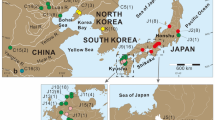Abstract
The Careproctus rastrinus species complex, widely known from the North Pacific, has been revealed recently to include nine genetically divergent groups on the basis of mitochondrial DNA (mtDNA) sequence variations. Herein we describe an AFLP analysis that focuses on three closely related groups in order to clarify the evolutionary history of the species complex in the Sea of Japan and off the Pacific coast of Japan. A principal coordinate analysis indicated the absence of nuclear divergence in two groups defined by mtDNA variations in the Sea of Japan, whereas another group from the Pacific coast of northern Japan was clearly distinct. This suggests extensive gene flow between two groups in the Sea of Japan as a result of secondary contact.

Similar content being viewed by others
References
Alvarado Bremer JR, Viñas J, Mejuto J, Ely B, Pla C (2005) Comparative phylogeography of Atlantic bluefin tuna and swordfish: the combined effects of vicariance, secondary contact, introgression, and population expansion on the regional phylogenies of two highly migratory species. Mol Phylogenet Evol 36:169–187
Bensch S, Åkesson M (2005) Ten years of AFLP in ecology and evolution: why so few animals? Mol Ecol 14:2899–2914
Chernova NV, Stein DL, Andriashev AP (2004) Family Liparidae Scopoli 1777—Snailfishes. Calif Acad Sci Annotated Checklist Fishes 31:1–72
Hubisz MJ, Falush D, Stephens M, Protchard JK (2009) Inferring weak population structure with the assistance of sample group information. Mol Ecol Res 9:1322–1332
Kai Y, Orr JW, Sakai K, Nakabo T (2011) Genetic and morphological evidence for cryptic diversity in the Careproctus rastrinus species complex (Liparidae) of the North Pacific. Ichthyol Res 58:143–154
Kido K (1988) Phylogeny of the family Liparididae, with the taxonomy of the species found around Japan. Mem Fac Fish Hokkaido Univ 35:125–256
Kojima S, Segawa R, Hayashi I, Okiyama M (2001) Phylogeography of a deep-sea demersal fish, Bothrocara hollandi, in the Japan Sea. Mar Ecol Prog Ser 217:135–143
Liu J-X, Gao T-X, Wu S-F, Zhang Y-P (2007) Pleistocene isolation in the northwestern Pacific marginal seas and limited dispersal in a marine fish, Chelon haematocheilus (Temminck and Schlegel, 1845). Mol Ecol 16:275–288
Mecklenburg CW, Mecklenburg TA, Thorsteinson LK (2002) Fishes of Alaska. Am Fish Soc, Bethesda
Nei M, Li WH (1979) Mathematical model for studying genetic variation in terms of restriction endonucleases. Proc Natl Acad Sci USA 77:5269–5273
Orr JW, Maslenikov KP (2007) Two new variegated snailfishes of the genus Careproctus (Teleostei: Scorpaeniformes: Liparidae) from the Aleutian Islands, Alaska. Copeia 2007:699–710
Peakall R, Smouse PE (2006) GENALEX 6: genetic analysis in Excel. Population genetic software for teaching and research. Mol Ecol Notes 6:288–295
Pritchard JK, Stephens M, Donnelly P (2000) Inference of population structure using multilocus genotype data. Genetics 155:945–959
Stefanni S, Knutsen H (2007) Phylogeography and demographic history of the deep-sea fish Aphanopus carbo (Lowe, 1839) in the NE Atlantic: vicariance followed by secondary contact or speciation? Mol Phylogenet Evol 42:38–46
Tyler PA (2002) Deep-sea eukaryote ecology of the semi-isolated basins off Japan. J Oceanogr 58:333–341
Van de Peer Y, De Wachter R (1994) TREECON for Windows: a software package for the construction and drawing of evolutionary trees for the Microsoft Windows environment. Comp Appl Biosci 10:569–570
Vos P, Hogers R, Bleeker M, Reijan M, van de Lee T, Hornes M, Frijters A, Pot J, Peleman J, Kuiper M, Zabeau M (1995) AFLP: a new technique for DNA fingerprinting. Nucl Acid Res 23:4407–4414
Acknowledgments
We greatly appreciate T.W. Pietsch and K.P. Maslenikov (UW) for curatorial assistance. We sincerely thank A. Yamasaki, T. Miyajima, K. Fujiwara, and the crews of R/V Heian-maru (Kyoto Prefectural Agriculture, Forestry and Fisheries Technology Center, Japan) and T. Wada (Fukushima Prefecture, Japan) for help in collecting specimens. This study was supported in part by a Grant-in-Aid for Scientific Research (B) from the Japan Society for the Promotion of Science (JSPS) (20370034).
Author information
Authors and Affiliations
Corresponding author
About this article
Cite this article
Kai, Y., Sakai, K., Orr, J.W. et al. Secondary contact in the Sea of Japan: the case of the Careproctus rastrinus species complex (Liparidae). Ichthyol Res 58, 366–369 (2011). https://doi.org/10.1007/s10228-011-0226-2
Received:
Revised:
Accepted:
Published:
Issue Date:
DOI: https://doi.org/10.1007/s10228-011-0226-2




